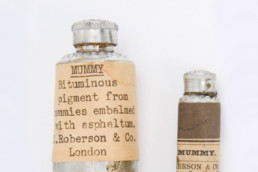Ever heard of the Forbes Pigment Collection? The Straus Center for Conservation and Preservation at the Harvard Art Museums stores the Forbes Pigment Collection – a library that is definitely one of a kind.
It was the historian and director of the Fogg Art Museum at Harvard Universities Edward Forbes, who started the collection of pigments in the 1920s. Forbes was fascinated by a painting’s color, the techniques of a painter and how paintings could be restored, respectively. He travelled around the world to add pigments to his collection and hired chemist Rutherford Gettens to help analyze those. Roughly 2,500 rare and historic pigments (and their precise chemical composition) are stored in the vault, which can only be seen through glass windows.
Edward Forbes is seen as the father of the field of art conservation in the United States, not for nothing. The following are some highlights of the collection.

Ultramarine – A precious blue
Back in the day ultramarine was more expensive than gold. The lapis lazuli stone had to be mined in Afghanistan and then shipped to experts overseas, who were able to extract the blue hue from small particles of the stone. Hence, this deep blue powder was extremely expensive. It was used in medieval paintings.
Later, a chemist created a synthetic (chemically identical) version of this brilliant blue that made it affordable to people around the world.

Mauve – The royal purple
Tyrian purple is a dye extracted from the murex shellfish that has an extremely eye catching color range. Due to it’s difficulty of manufacture, desirable shade and resistance to fade it was extremely expensive and therefore a status symbol – hence often called the ‘royal purple’.

Emerald Green – A toxic shade of green
The crystalline emerald green powder of copper acetoarsenite is an extremely toxic pigment. Amongst others Vincent van Gogh used this pigment in his paintings, e.g. in the vibrant background of “Self-Portrait Dedicated to Paul Gauguin”. The poisonous fumes alone were a major health hazard.

Mummy – A bizarre kind of brown
The so called mummy brown was gained by extracting the brown resing material of harvested mummies. People were obsessed in finding out how to recreate the rich brown that Rembrandt and Titian used in their masterworks.
Today, the collection has expanded and also includes modern pigments, which is used for comparison and scientific analysis.
Each year the Forbes Pigment Collection gets extended by additions of innovated colors, like the superblack Vantablack that absorbes 99.965% of light.